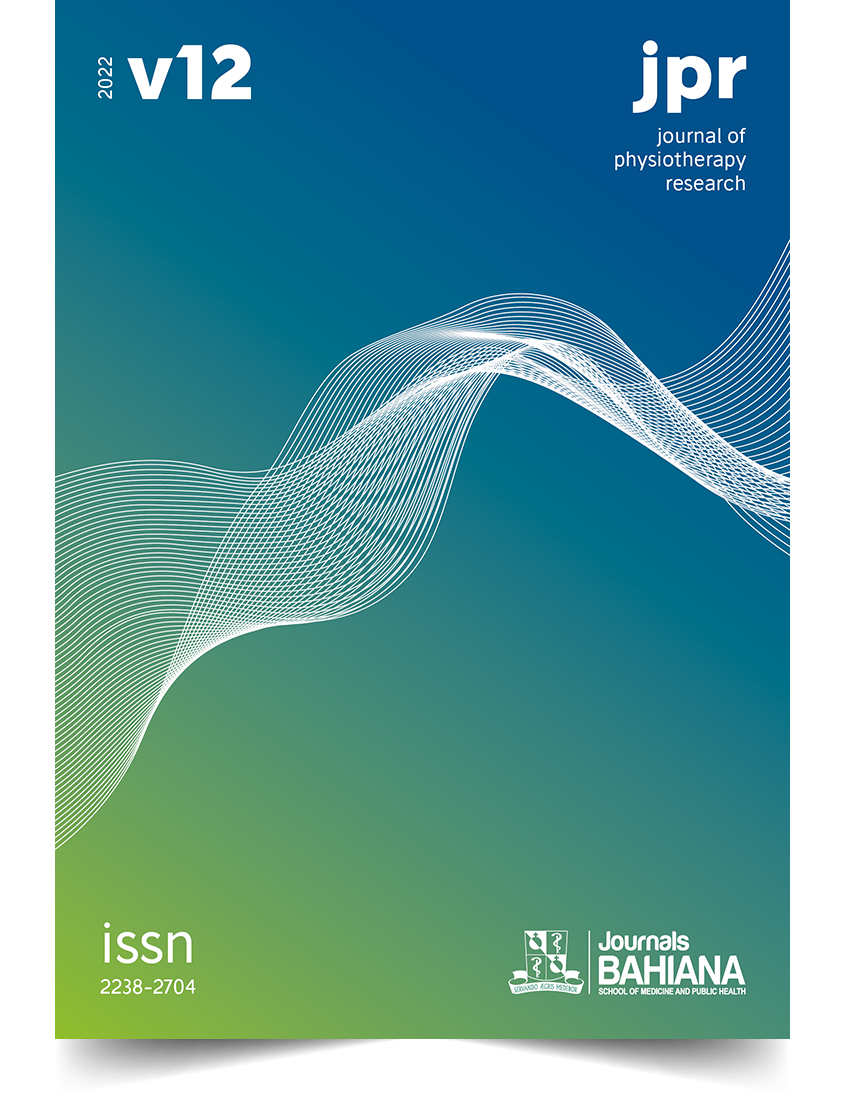Reliability of the evaluation of shoulder girdle retraction in a neonatal intermediate unit care
DOI:
https://doi.org/10.17267/2238-2704rpf.2022.e4416Keywords:
Shoulder girdle retraction, Newborns, Infants, Shoulder bladesAbstract
OBJECTIVE: To evaluate the inter and intra-examiner reliability in the use of instruments to assess shoulder girdle retraction in children hospitalized in a neonatal intermediate care unit. METHODS: Quantitative, cross-sectional and observational study, carried out with newborns and infants who required hospitalization in a neonatal intermediate care unit. Data collection took place from October 2019 to February 2020. To evaluate the retraction of the shoulder girdle, a biomechanical inspection protocol developed by the researchers was used, which made it possible to measure (in centimeters) from the upper and lower medial edges, right and left, to the spine, with the head in rotation to right and left, and the scarf sign. The evaluations were always carried out by the same evaluators. To estimate the inter- and intra-examiner reliability of the biomechanical inspection protocol and scarf signal, the Kappa Index was used and, for measurements of scapular positioning, the Intraclass Correlation Coefficient. RESULTS: The biomechanical inspection protocol for signs suggestive of scapular girdle retraction showed mild to moderate inter-examiner agreement and substantial to almost perfect intra-examiner agreement. The intra-examiner agreement obtained in the scarf sign was mild to moderate, and almost perfect intra-examiner. The positioning of the scapulae showed good inter-examiner agreement and excellent intra-examiner agreement. CONCLUSION: The evaluation of signs suggestive of scapular girdle retraction in newborns and infants has low inter-examiner reliability and very high intra-examiner reliability.
Downloads
References
Lessa NMC. Avaliação do desenvolvimento postural e do desempenho motor em crianças de 4 a 6 anos de idade nascidas prematuras: visão fisiterapêutica [dissertação] [Internet]. Rio de Janeiro: Instituto Fernandes Figueira, Fundação Oswaldo Cruz; 2006. Available from: https://www.arca.fiocruz.br/handle/icict/3495
Toso BRGO, Viera CS, Valter JM, Delatore S, Barreto GMS. Validation of Newborn positioning protocol in Intensive Care Unit. Rev Bras Enferm. 2015;68(6):835-41. https://doi.org/10.1590/0034-7167.2015680621i
Moreira EG, Grave MTQ. Avaliação do desenvolvimento motor de crianças prematuras nascidas em uma pequena cidade do do Vale do Rio dos Sinos. Revista Destaques Acadêmicos [Internet]. 2014;6(3):64-71. Available from: http://www.univates.br/revistas/index.php/destaques/article/view/416
Lanza FC, Gazzoti MR, Palazzin A. Fisioterapia em Pediatria e Neonatologia da UTI ao Ambulatório. São Paulo: Editora Manole; 2012.
Prado C, Vale LA. Fisioterapia Neonatal e Pediátrica. São Paulo: Editora Manole; 2012.
Moreira AMNM. A intervenção precoce em recém-nascidos pré-termo: o posicionamento, a correcção postural e neuromuscular [dissertação] [Internet]. Porto: Universidade do Porto; 2004. Available from: https://hdl.handle.net/10216/23342
Groot L. Posture and Mobility in preterm infants. Developmental Medicine & Child Neurology. 2000;42(1):65-8. https://doi.org/10.1111/j.1469-8749.2000.tb00028.x
Oliveira MP, Melo MFA, Sá SMP. Retração Escapular e RN prematuros Sob Ventiação Mecânica Invasiva: Relato de Caso. Anais da XII Mostra Científica e Cultural da Bahiana; 2012; Salvador, BA.
Johansen K, Persson K, Sonnander K, Magnusson M, Sarkadi A, Lucas S. Clinical utility of the Structured Observation of Motor Performance in Infants Within the child health services. PLOS ONE. 2017;12(7):e0181398. https://doi.org/10.1371/journal.pone.0181398
Gomes JS, Albergaria TFS, Flor CJDRV, Pinto Júnior EP, Gomes IML. Scapular waist retraction in newborns admitted to an Intermediate Care Unit. Rev Pesqui Fisioter. 2021;11(1):96-105. https://doi.org/10.17267/2238-2704rpf.v11i1.3369
Amiel-Tison C. A method for neurologic evaluation within the first year of life. Curr Probl Pediatr. 1976;7(1):1-50. Cited: PMID: 975863.
Georgieff MK, Bernbaum JC. Abnormal shoulder girdle muscle tone in premature infants during their first 18 months of life. Pediatrics. 1986;77(5):664-9. Cited: PMID: 3703633.
Leksulchai R, Cole J. Scarf ratio: A method of measuring the Scarf Sign in preterm born infants. Aust J Physiother. 2000;46(2):85-90. https://doi.org/10.1016/s0004-9514(14)60316-0
Silva RS, Paes AT. Teste de concordância Kappa. Einsten: Educ Contin Saúde [Internet]. 2012;10(4):165-6. Available from: http://apps.einstein.br/revista/arquivos/PDF/2715-165-166.pdf
Terry KK, Mae YL. A Guideline of Selecting and Reporting Intraclass Correlation Coefficients for Reliability Research. J Chiropr Med. 2016;15(2):155–63. https://doi.org/10.1016/j.jcm.2016.02.012
Tecklin JS. A criança de alto risco. In: Fisioterapia pediátrica. Porto Alegre: Artmed; 2002. p.69-96.
Boyd EA, Torrance GM. Clinical measures of shoulder subluxation: their reliability. Can J Public Health. 1992;83 (Suppl 2):S24-8. Cited: PMID: 1468045.
Downloads
Published
Issue
Section
License
Copyright (c) 2022 Lara Sampaio Franca Santos, Tatiane Falcão dos Santos Albergaria, Carmen Júlia Del Rey Villa Flor, Elzo Pereira Pinto Junior, Rhaine Borges Santos Pedreira

This work is licensed under a Creative Commons Attribution 4.0 International License.
This work is licensed under a Creative Commons Attribution 4.0 International License.



